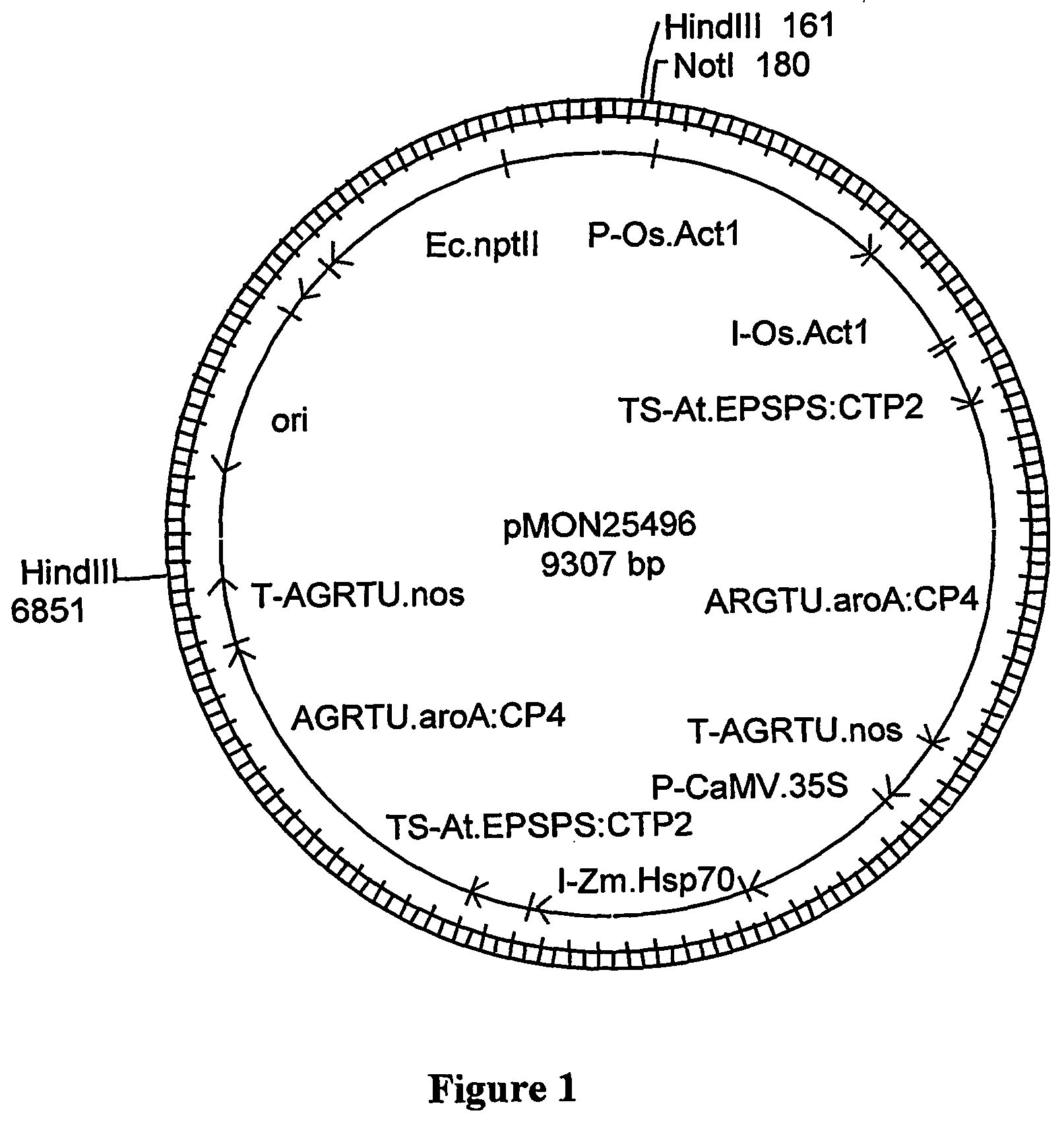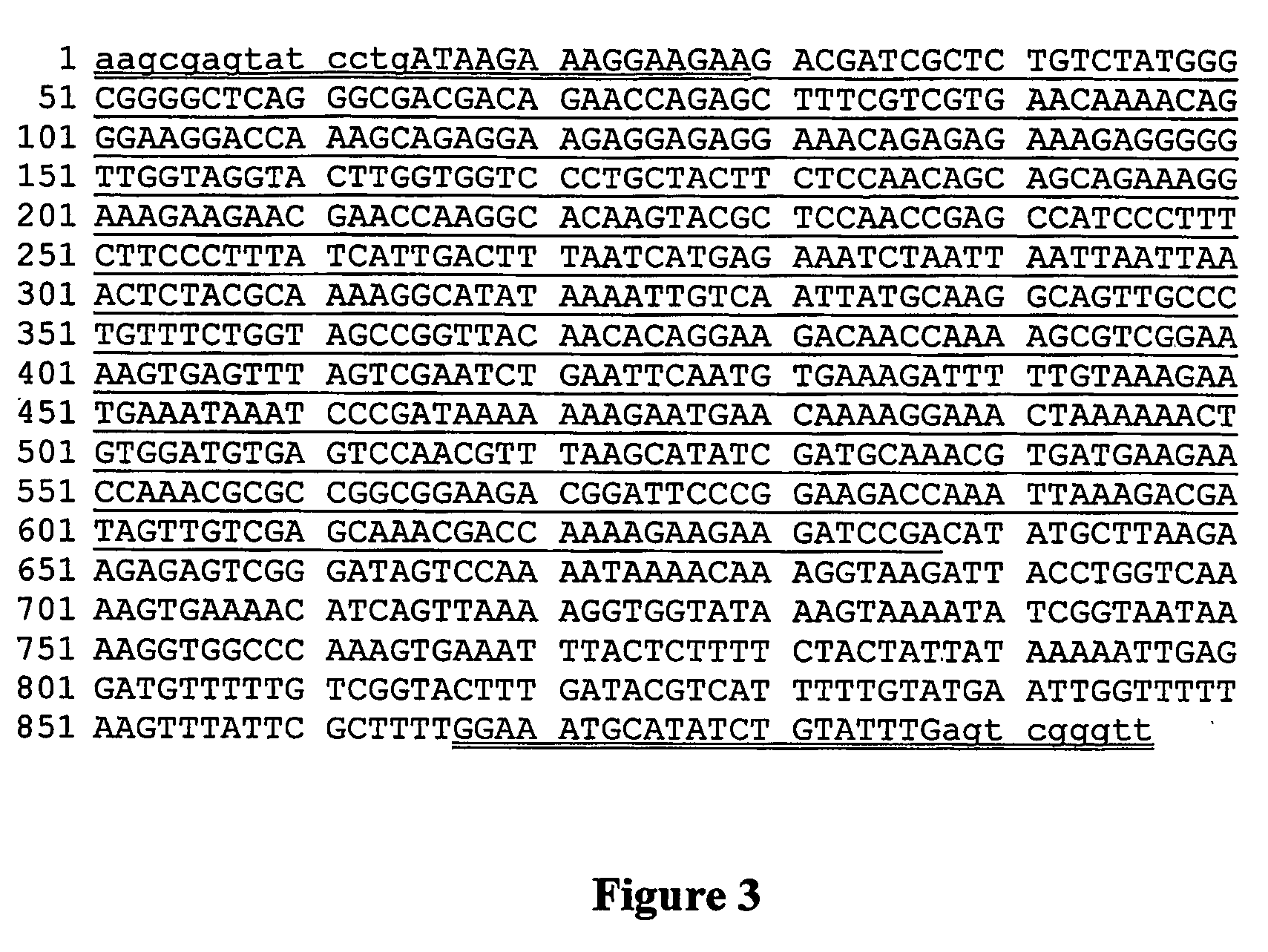Bentgrass event asr-368 and compositions and methods for detection thereof
a technology of event asr-368 and bentgrass, applied in the field of plant molecular biology, can solve the problems of inability to use broadleaf herbicides on bentgrass golf greens, inability to discriminate between different events, and difficult to control bentgrass weeds
- Summary
- Abstract
- Description
- Claims
- Application Information
AI Technical Summary
Benefits of technology
Problems solved by technology
Method used
Image
Examples
example 1
[0048] The transgenic bentgrass event ASR-368 was generated by microprojectile bombardment of bentgrass line B99061R / 990028 using a linear HindIII DNA fragment derived from pMON25496 (FIG. 1) that comprises the transgene insert of the present invention. This DNA fragment contains two transgene expression cassettes that collectively confer bentgrass ASR-368 plant tolerance to glyphosate. The first cassette is composed of the rice actin 1 promoter and intron (P-Os.Act1, also referred to as P-ract, and the intron I-Os.Act1, also referred to as ract intron, U.S. Pat. No. 5,641,876), operably connected to an Arabidopsis EPSPS chloroplast transit peptide (TS-At.EPSPS:CTP2, also referred to as ctp2, Klee et al., Mol. Gen. Genet. 210:47-442, 1987), operably connected to a glyphosate tolerant 5-enol-pyruvylshikimate-3-phosphate synthase (EPSPS) from Agrobacterium sp. strain CP4 (AGRTU.aroA:CP4 EPSPS, also known as cp4, U.S. Pat. No. 5,633,435) and operably connected to a nopaline synthase tr...
example 2
[0049] The glyphosate tolerant bentgrass event ASR-368 was tested for tolerance to glyphosate vegetative injury. The glyphosate tolerant bentgrass event ASR-368 showed no damage to 5% Roundup® Pro (glyphosate containing herbicide formulation) sprayed with a hand sprayer or an amount equivalent to 128 ounces Roundup® Pro per acre. The standard recommended rate is 1.25 to 2.5% Roundup® Pro or amount equivalent to 32 to 64 ounces Roundup® Pro per acre. Three applications of the glyphosate containing herbicide formulation during the growing season, early summary, mid-summer and early fall were used to test for glyphosate tolerance in a turfgrass stand of event ASR-368. Bentgrass event ASR-368 showed glyphosate tolerance to all applications of glyphosate at three test locations. No vegetative injury was observed on event ASR-368, while bentgrass plants not containing pMON25496 were all heavily injured or killed by the glyphosate containing herbicide formulation treatment. Treatment of be...
example 3
[0050] The DNA sequences of the 5′ and 3′ genomic regions adjacent to the transgene insert are determined by isolation of the DNA molecules using Clontech's Universal Genome Walker™ Kit and the RAGE method (Rapid Amplification of Genomic DNA Ends). The 5′ transgene / genomic DNA (FIG. 3) is isolated from bentgrass ASR-368 genomic DNA by: digestion overnight at 37° C. with HindIII, and digestion of pBluescript KS plasmid (Stratagene, La Jolla Calif.) for 3 hours at 37° C. with XbaI. The four nucleotide base overhangs are filled in with two nucleotides to become compatible for ligation. The genomic DNA is ligated with the XbaI digested / 2 nucleotide base filled pBluescript KS plasmid by incubation with T4 DNA ligase under the appropriate conditions. After ligation reaction, 5 μl of the ligation mix is used in a DNA amplification method with 2 μl of 10 μM M13 forward primer (SEQ ID NO:5), 2 μl 10 μM ASR-368 transgene-specific oligonucleotide primer (SEQ ID NO:6), 1.75 μl 10 mM deoxyribonu...
PUM
| Property | Measurement | Unit |
|---|---|---|
| temperature | aaaaa | aaaaa |
| temperature | aaaaa | aaaaa |
| temperature | aaaaa | aaaaa |
Abstract
Description
Claims
Application Information
 Login to View More
Login to View More - R&D
- Intellectual Property
- Life Sciences
- Materials
- Tech Scout
- Unparalleled Data Quality
- Higher Quality Content
- 60% Fewer Hallucinations
Browse by: Latest US Patents, China's latest patents, Technical Efficacy Thesaurus, Application Domain, Technology Topic, Popular Technical Reports.
© 2025 PatSnap. All rights reserved.Legal|Privacy policy|Modern Slavery Act Transparency Statement|Sitemap|About US| Contact US: help@patsnap.com



